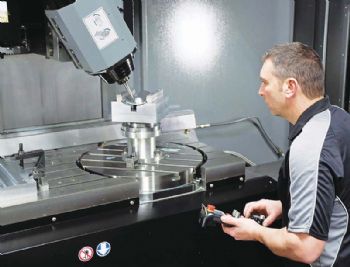
#MACH2018 Some 20 years ago, the then specialist electric discharge machining (EDM) sub-contractor RST Engineering decided that a manual-tool-change Hurco Hawk with a twin-screen control system offering easy-to-use shopfloor programming was probably the best CNC milling machine to take over from hand-operated mills for manufacturing copper electrodes, jigs and fixtures.
This decision followed a 10min demonstration on the Hurco (
www.hurco.co.uk) stand at the
MACH 1998 machine tool show.
After the machine was installed, its performance was such that RST had no hesitation in replacing it in 2002 with an automatic-tool-change three-axis Hurco VM2 machining centre, which was equipped with a similar proprietary Ultimax twin-screen control, as well as a Nikken fourth-axis table.
Over the next decade, RST milled and drilled an increasing amount of its customers’ components on the VM2.

This work had previously been sub-contracted to another firm, so bringing it in-house saved money and gave RST more control over production scheduling and delivery lead times.
Today, the VM2 is used only for machining electrodes; it is located in the company’s EDM shop, alongside four wire erosion machines, four die sinkers and two EDM hole-drilling machines.
While EDM work remains an important part of the business, RST has a new ‘milling shop’ in an adjacent unit. Here, three additional Hurco machining centres — a larger three-axis machine and two five-axis models — have taken over production of the company’s machining of prismatic components, which are mainly made of aluminium, stainless steel and titaniums.
All these machines are fitted with Hurco’s latest WinMax twin-screen control, which provides a high level of functionality for conversational shopfloor programming — and even generates 3+2-axis cycles. Today, the milling side of RST’s business accouns for more than a third of its turnover.
A family affair
RST was established in 1986 by Robert and Maureen Taylor and is now run by their three sons — Sean, Jason and Paul.
The company produces components for a wide range of industries, including communications, aerospace, medical and scientific research — as well as for ‘more unusual customers’ making bespoke clocks and shotguns, for example.
Jason Taylor said: “Around 40% of our business is in aerospace and involves wiring, sparking and milling satellite communications components such as waveguides and diplexers; we also do some second-tier work producing components such as gimbals and joints for military aircraft.
“We gained AS9100 aerospace quality management accreditation last December, and we are looking to expand in this sector by taking on long-term commercial-aircraft contracts, hopefully building them to account for a quarter of our business in a few years’ time.”

Increasing the focus on aerospace work had been in the company’s sights for several years, as was the relocation in August 2016 to two new 7,100ft2 premises (on the Young’s Industrial Estate in Leighton Buzzard) that are two and a half times larger than RST’s previous facilities.
The move entailed a £300,000 investment, which included the purchase of a co-ordinate measuring machine and a Hurco VMX60SRTi five-axis machining centre with a B-axis spindle and a 1,524 x 660 x 610mm work envelope.
This machine joined a VMX30Ui (a smaller five-axis Hurco of swivelling trunnion design purchased two years earlier) and a larger three-axis Hurco VM30i (installed the year before to cope with a wider variety of component sizes).
In the previous factory, the VMX30Ui worked alongside a similar VMX30U five-axis machine, which was installed in 2009 and featured ‘older technology’ drives and control.
Jason Taylor was able to benchmark one five-axis model against the other and, highlighting the performance of the latest machine, said: “Cycle times were considerably reduced using the same program, and the improvement in surface finish was very apparent — especially when milling surfaces and transitions.
“Indeed, the gains were so great that we were prompted to part-exchange the older five-axis trunnion model and buy the bigger B-axis machine, which has similarly improved drives and control system.”
Complex programming
Only a small proportion of RST’s five-axis machining is fully interpolative, and this level of programming is undertaken off-line at a VISI CAD/CAM station.
The company’s 3+2-axis programming is shared between VISI and Hurco’s WinMax control software on the shopfloor, using the latter’s Transform Plane facility; three-axis routines are produced entirely in WinMax.
Another feature of the software that RST staff appreciate is NC Merge (
blog.hurco.com/blog/bid/194602/Hurco-s-NC-Merge-the-best-of-both-worlds), which allows three-axis parts of a cycle to be prepared at the control and merged with five-axis sections programmed in VISI.
The load on the off-line CAD/CAM station is reduced; and in any case, Jason Taylor says that three-axis programming is more efficiently completed conversationally in WinMax.
“It is even possible to program on the shopfloor and start running three-axis/2-D blocks of code on a machine and tack on five-axis/3-D blocks downloaded from VISI afterwards, saving time when proving out jobs.
“The latest Hurco B-axis machine is very versatile and well suited to sub-contracting, as it can produce five-axis parts up to 600mm in diameter on the rotary table and a second three- or four-axis part on the fixed table to the side, giving Op1/Op2 possibilities.
Alternatively, one large component up to 1.5m in X x 660mm in Y can be three-axis-milled and drilled. The machine holds very tight positional and dimensional tolerances — down to ±10µm in five-axis working and half that when interpolating three axes — and with excellent repeatability.
With our trunnion-type five-axis VMX30Ui and the other three-axis Hurcos, which also have 12,000rev/min spindles, we are in a good position to enter the civil-aerospace supply chain, now that we have AS9100.”